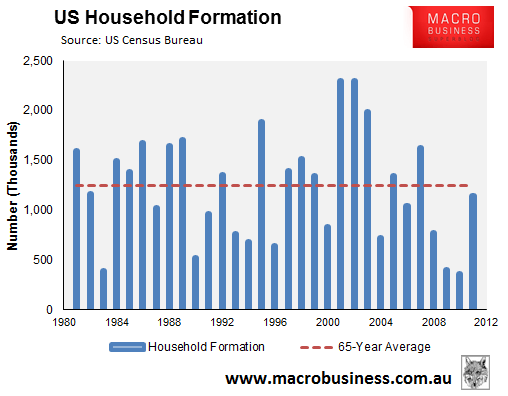
‘Underlying demand’ (or ‘pent-up’ demand) is the common method used in calculating whether there is a housing shortage. Put simply, underlying demand estimates what the demand for newly-built housing might be given the growth in population, trends in household size, demand for second (or holiday) homes, and economic conditions (e.g. employment, interest rates, etc). Underlying demand differs from ‘effective (actual) demand’, which is the quantity that owner-occupiers, investors and renters are actually able and willing to buy or rent in the housing market.
In the years leading-up to the US housing bust, underlying demand was running strong. Unemployment was low, the US economy was growing strongly, credit was readily available, and the number of new households being formed was running well above the long-term average of 1.25 million household formations per year (see next chart).

The surge in household formations led to numerous suggestions that the US was facing a housing shortgage, especially in areas where land supply was restricted, such as California, Nevada, and Arizona.
The rest is history. The US housing bubble burst, economic conditions deteriorated, and the rate of household formations fell to 65-year lows in the three years following the Global Financial Crisis, leading to a large oversupply of homes that exacerbated the downturn in both prices and rents.
An article published earlier in the week in USA Today provides further context on the slump in US housing demand caused by deteriorating economic conditions:
The Great Recession has upended the American tradition of moving to greener pastures. Instead of moving to a bigger home or for a higher-paying job, more Americans moved because they can’t afford to stay where they are.
During the 2007-09 recession, 9% of Americans — about 4 million — moved locally, the highest level in a decade. And a growing number moved to cheaper housing or doubled up with family and friends, according to an analysis out Wednesday of Census data through 2010…
People moved the most in metropolitan areas with the highest unemployment and highest foreclosure rates, particularly in hard-hit parts of the Sun Belt…
In Las Vegas, for example, one in five people moved locally during the recession…
“Typically, over the last couple of decades, when Americans moved, they moved to improve their lives,” says Michael Stoll, author of the research and chairman of UCLA’s public policy department. “This is the shock: For the first time, Americans are moving for downward economic mobility. Either they lost their house or can’t afford where they’re renting currently or needed to save money”…
The key lesson from the US experience is that the demand for housing is highly changeable depending, largely, on prevailing economic conditions.
Should economic conditions deteriorate significantly, such as through a disorderly unwinding of the mining boom, the number of Australians opting for group accommodation (or the number of young people moving back into mum and dad’s) could rise significantly, turning a perceived housing shortage into a surplus.
There is also the risk that any reduction of housing demand arising from deteriorating economic conditions crimps the rate of new home construction, in turn shattering the RBA’s and Treasury’s plans for housing to fill the void as the mining boom unwinds.

